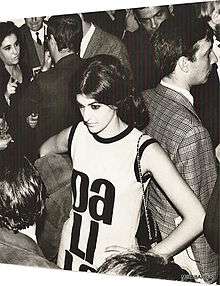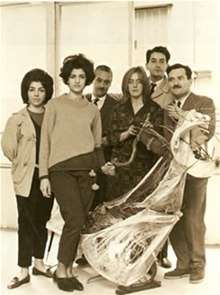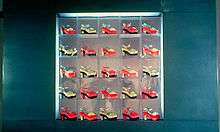Dalila Puzzovio
| Dalila Puzzovio | |
|---|---|
 Dalila Puzzovio (ca. 1965) | |
| Born |
1945 (age 72–73) Buenos Aires, Argentina |
| Nationality | Argentinean |
| Occupation |
Visual artist Fashion designer |
| Years active | 1961– present |
Dalila Puzzovio (born 1945) is an Argentine conceptual artist and fashion designer.


Early life and education
Puzzovio was born in Buenos Aires, Argentina.
She studied with Juan Batlle Planas and Jaime Davidovich.
Career
In 1961, she exhibited for the first time in Lirolay Gallery returning two years later for another exhibit, curated by the French artist, Germaine Derbecq. In 1964, she participated in an exhibition in Buenos Aires Modern Art Museum, curated by Rafael Squirru. She was part of the artistic core led by critic Jorge Romero Brest and including, among others, Antonio Berni, Jorge de la Vega, Juan Carlos Distefano, León Ferrari, Gyula Kosice, Alberto Greco, Delia Cancela, Pablo Mesejean, Julio Le Parc, Marta Minujín, Wells and Luis Federico Peralta Ramos. Artist, cartoonist, costumer and designer, she also excelled in designing furniture and shoes with her husband Carlos "Charlie" Squirru, whom he met in 1962 and with whom she traveled to New York.
The “Dalila doble plataforma” (Double Platform Dalila), a shoe created by Puzzovio, led to the artist’s winning of the Second International Di Tella Prize, because of its blend of art and fashion. She also created costumes for film, television and theater. She was awarded the 1966 National Grand Prize by Autorretrato en marquesina. Puzzovio is also remembered for the 1965 ¿Por qué son tan geniales? ("Why are they so great?") poster panel on the corner of Viamonte and Florida Streets in Buenos Aires which she created with her husband and Edgardo Giménez.[2]
References
- ↑ Podalsky, Laura (2004). Specular City: Transforming Culture, Consumption, and Space in Buenos Aires, 1955-1973. Temple University Press. pp. 142–. ISBN 978-1-56639-948-7.
- ↑ Katzenstein, Inés (2004). Listen, Here, Now!: Argentine Art of the 1960s : Writings of the Avant-garde. The Museum of Modern Art. pp. 184–. ISBN 978-0-87070-366-9.
External links
|
|
| Wikimedia Commons has media related to Dalila Puzzovio. |
- Official website (in Spanish)
- ¿Por qué son tan geniales? ad campaign (in Spanish)